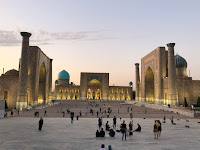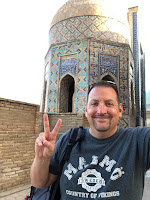Samarkand, or
Samarqand in Uzbek, is in southeastern
Uzbekistan. It is one of the oldest continuously inhabited places in
Central Asia. It's 240 km (149 miles) from
Bukhara and 344 km (214 miles) from
Tashkent. It's only about 35 km (22 miles) to the Tajik border.
 It is believed that the city was founded between the 8th and 7th centuries with evidence of human activity from the late Palaeolithic Era. With about 520.000 residents, and 950.000 in the greater metro area, Samarkand is one of the biggest cities in the country.
It is believed that the city was founded between the 8th and 7th centuries with evidence of human activity from the late Palaeolithic Era. With about 520.000 residents, and 950.000 in the greater metro area, Samarkand is one of the biggest cities in the country.
 Samarkand was conquered by Alexander the Great in 329 BC. It was then ruled by numerous Iranian and Turkic rulers until Genghis Khan and the Mongols conquered it in 1220. In 1868 the city was annexed by the Russian Empire. From 1925 to 1930 it was the capital of the Uzbek Soviet Socialist Republic before the capital was moved to Tashkent.
Samarkand was conquered by Alexander the Great in 329 BC. It was then ruled by numerous Iranian and Turkic rulers until Genghis Khan and the Mongols conquered it in 1220. In 1868 the city was annexed by the Russian Empire. From 1925 to 1930 it was the capital of the Uzbek Soviet Socialist Republic before the capital was moved to Tashkent.
 Due to its position on the Silk Route the city has been a crossroads of cultures and in 2001 Samarkand was listed as a World Heritage Site.
Due to its position on the Silk Route the city has been a crossroads of cultures and in 2001 Samarkand was listed as a World Heritage Site.
 Registan was the heart of the old city. The architecture of the public square and its three madrasahs is simply stunning. Especially at night.
Registan was the heart of the old city. The architecture of the public square and its three madrasahs is simply stunning. Especially at night.

 The Amir Temur Mausoleum was completed in 1404. Inscribed in the tomb is a warning that reads "Whosoever disturbs my tomb will unleash an invader more terrible than I." The tomb was opened in 1941, two days before Nazi Germany invaded the Soviet Union. The story goes that Stalin believed the curse and ordered that Amir Temur be reburied.
The Amir Temur Mausoleum was completed in 1404. Inscribed in the tomb is a warning that reads "Whosoever disturbs my tomb will unleash an invader more terrible than I." The tomb was opened in 1941, two days before Nazi Germany invaded the Soviet Union. The story goes that Stalin believed the curse and ordered that Amir Temur be reburied.
 The Ulugh Beg Observatory was built in the 1420s. It was destroyed in 1449 and rediscovered in 1908. It's said to have been one of the finest observatories in the Islamic world. It became a museum in 1970.
The Ulugh Beg Observatory was built in the 1420s. It was destroyed in 1449 and rediscovered in 1908. It's said to have been one of the finest observatories in the Islamic world. It became a museum in 1970.
 Islom Karimov was President of the Uzbek SSR in 1990 until he declared independence in 1991. He then became the first President and remained so until his death in 2016. Another former Soviet leader that remained in power for more than 25 years.
Islom Karimov was President of the Uzbek SSR in 1990 until he declared independence in 1991. He then became the first President and remained so until his death in 2016. Another former Soviet leader that remained in power for more than 25 years.

I believe that the Memorial Complex of the First President of the Republic of Uzbekistan opened in 2018.

The Shah-i-Zinda is a complex of mausoleums and other ritual buildings. There are more than twenty buildings dating from the 11th to 19th centuries.
 Legend has it that a cousin of the Prophet Muhammad is buried here. The complex is enormous and you could spend half a day here checking everything out and taking photos.
Legend has it that a cousin of the Prophet Muhammad is buried here. The complex is enormous and you could spend half a day here checking everything out and taking photos.
 The Bibi-Khanym Mosque was completed in 1404. During the 15th century it was one of the world's largest mosques.
The Bibi-Khanym Mosque was completed in 1404. During the 15th century it was one of the world's largest mosques.
 Across from the mosque is the Bibi-Khanym mausoleum. The 14th century mausoleum is home to five tombs.
Across from the mosque is the Bibi-Khanym mausoleum. The 14th century mausoleum is home to five tombs.
 The Gumbaz Synagogue was built in 1891. This is a working temple for the city's approximate 50 Jews.
The Gumbaz Synagogue was built in 1891. This is a working temple for the city's approximate 50 Jews.

 During the day I came across Orthodox, Muslim, and Jewish cemeteries.
During the day I came across Orthodox, Muslim, and Jewish cemeteries.

The Slyob Bazaar is the city's largest bazaar. Quite popular with both locals and tourists.

Sadreddin Ayni was the father of modern Uzbek and Tajik literature. His homes turned in to a museum in 1967. I'd never heard of him before the museum was interesting.

Afrasiab Museum of Samarkand is one of the largest archaeological sites in the world.

The Mausoleum of Saint Daniel, the prophet from the Old Testament, is visited by Jews, Christians, and Muslims.
 He rests in an 18 metre (59 foot) sarcophagus. Legend has it that it is because his remains continue to grow. The more likely version is that this made it harder for grave robbers to disturb his remains.
He rests in an 18 metre (59 foot) sarcophagus. Legend has it that it is because his remains continue to grow. The more likely version is that this made it harder for grave robbers to disturb his remains.
 It is believed that the city was founded between the 8th and 7th centuries with evidence of human activity from the late Palaeolithic Era. With about 520.000 residents, and 950.000 in the greater metro area, Samarkand is one of the biggest cities in the country.
It is believed that the city was founded between the 8th and 7th centuries with evidence of human activity from the late Palaeolithic Era. With about 520.000 residents, and 950.000 in the greater metro area, Samarkand is one of the biggest cities in the country.
















































No comments:
Post a Comment